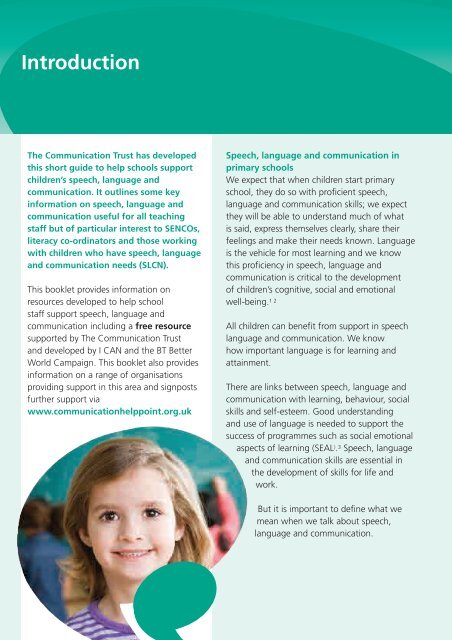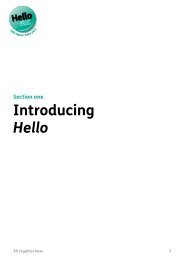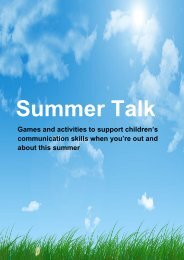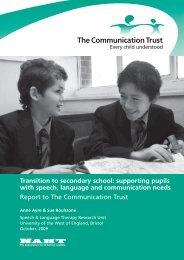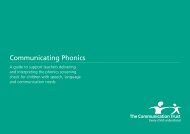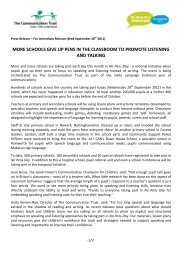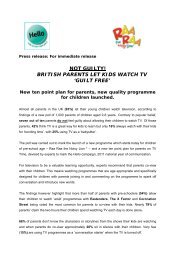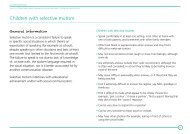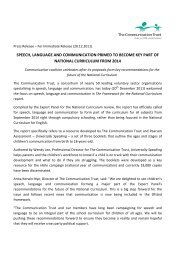Speech, language and communication - The Communication Trust
Speech, language and communication - The Communication Trust
Speech, language and communication - The Communication Trust
Create successful ePaper yourself
Turn your PDF publications into a flip-book with our unique Google optimized e-Paper software.
Introduction<br />
<strong>The</strong> <strong>Communication</strong> <strong>Trust</strong> has developed<br />
this short guide to help schools support<br />
children’s speech, <strong>language</strong> <strong>and</strong><br />
<strong>communication</strong>. It outlines some key<br />
information on speech, <strong>language</strong> <strong>and</strong><br />
<strong>communication</strong> useful for all teaching<br />
staff but of particular interest to SENCOs,<br />
literacy co-ordinators <strong>and</strong> those working<br />
with children who have speech, <strong>language</strong><br />
<strong>and</strong> <strong>communication</strong> needs (SLCN).<br />
This booklet provides information on<br />
resources developed to help school<br />
staff support speech, <strong>language</strong> <strong>and</strong><br />
<strong>communication</strong> including a free resource<br />
supported by <strong>The</strong> <strong>Communication</strong> <strong>Trust</strong><br />
<strong>and</strong> developed by I CAN <strong>and</strong> the BT Better<br />
World Campaign. This booklet also provides<br />
information on a range of organisations<br />
providing support in this area <strong>and</strong> signposts<br />
further support via<br />
www.<strong>communication</strong>helppoint.org.uk<br />
<strong>Speech</strong>, <strong>language</strong> <strong>and</strong> <strong>communication</strong> in<br />
primary schools<br />
We expect that when children start primary<br />
school, they do so with proficient speech,<br />
<strong>language</strong> <strong>and</strong> <strong>communication</strong> skills; we expect<br />
they will be able to underst<strong>and</strong> much of what<br />
is said, express themselves clearly, share their<br />
feelings <strong>and</strong> make their needs known. Language<br />
is the vehicle for most learning <strong>and</strong> we know<br />
this proficiency in speech, <strong>language</strong> <strong>and</strong><br />
<strong>communication</strong> is critical to the development<br />
of children’s cognitive, social <strong>and</strong> emotional<br />
well-being. 1 2<br />
All children can benefit from support in speech<br />
<strong>language</strong> <strong>and</strong> <strong>communication</strong>. We know<br />
how important <strong>language</strong> is for learning <strong>and</strong><br />
attainment.<br />
<strong>The</strong>re are links between speech, <strong>language</strong> <strong>and</strong><br />
<strong>communication</strong> with learning, behaviour, social<br />
skills <strong>and</strong> self-esteem. Good underst<strong>and</strong>ing<br />
<strong>and</strong> use of <strong>language</strong> is needed to support the<br />
success of programmes such as social emotional<br />
aspects of learning (SEAL ) . 3 <strong>Speech</strong>, <strong>language</strong><br />
<strong>and</strong> <strong>communication</strong> skills are essential in<br />
the development of skills for life <strong>and</strong><br />
work.<br />
But it is important to define what we<br />
mean when we talk about speech,<br />
<strong>language</strong> <strong>and</strong> <strong>communication</strong>.


